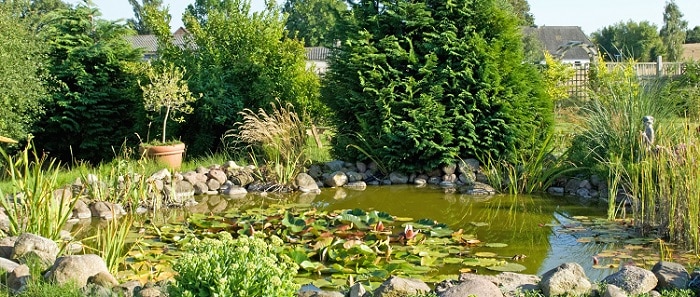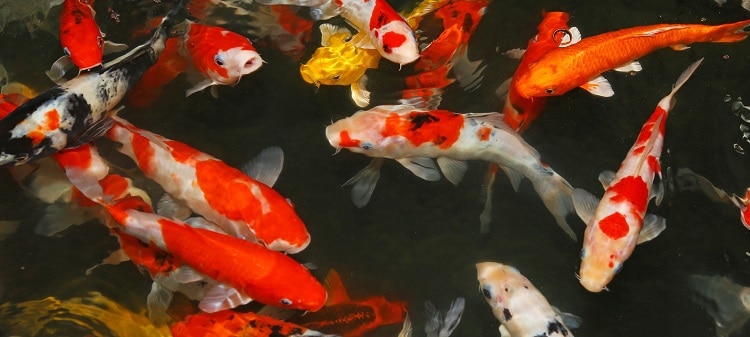Ponds are delightful bodies of water that can be filled with beautiful plant life and fish. This is why so many homeowners opt to create a pond of their own in the backyard. But knowing where to place a pond is important. It can be hard to know whether or not a pond should be in full sun or not can be challenging due to contradicting information circulating.
Ponds can be in full sunlight for 4 to 6 hours per day. This will provide a healthy and safe environment for the aquatic plant life and fish. Not enough sunlight will stunt the growth of aquatic life. It’s best to find a spot with 4 to 6 hours of sunlight and offer shade for the fish.
If you’re ready to really consider whether or not you want to create a pond in your yard, you have come to the right place. We are going to be taking an in-depth look at whether or not a pond should be in full sun or not. We will be discussing the pros and cons and how you can create the ideal space for your pond.
Adding a pond to your backyard can create a soothing, relaxing environment. But knowing where to build it is the key to success. Some websites will tell you that shady areas should be avoided, while others state too much sunlight can have a negative impact. What’s the truth? Let’s take a look at the few pros of building a pond in direct sunlight.
Pros of Building a Pond in Full Sun

Aquatic Plants Will Thrive
For years it has been thought that ponds should have at least 4 to 6 hours of sunlight for the plants and fish to thrive. It is highly discouraged to build a pond in a shady location. For the most part, this is true. Aquatic plants will thrive in an area that gets a good amount of sunlight per day.
Some aquatic plant life, including water lilies and lotus, require at least 5 to 6 hours of sunlight per day. Without adequate sunlight, the flowers will be unable to bloom properly. Since water lilies and lotus are particularly popular pond aquatic plant life, it’s something to consider when choosing a spot for your pond.
That does not mean that the plants will die if left in an area with little light, though. It simply means more work for the pond owner. This is because, with less sunlight, the aquatic plants will require help with fertilization. The pond owner will need to add fertilizer, with a time-release aquatic plant fertilizer being the best choice.
Whether you are providing full sun or supplementing with fertilizer, it’s important to remember to always ensure that the aquatic plants have enough room to grow. Without a proper area to dig their roots into, the growth can become stunted.
It is recommended to plant aquatic plants that enjoy the shade when opting out of the full sun. These plants are also ideal for those who can’t provide full sun for their pond. These plants include:
- Water Hyacinths
- Frog-Bit
- Azolla
- Water Clover
- Pennywort
- Umbrella Palm
- Water Celery
- Brooklime
- Marsh Marigold
- Water Forget-Me-Not
It’s Better for Fish, Too
A pond that is placed in direct sunlight for at least 4 to 6 hours per day will also benefit the fish. It is beneficial in two ways:
- The fishs’ colors will become brighter and more vibrant, and
- The sunlight will warm the pond water, which is especially necessary during the winter.
The sunlight will bring out the colors of your pond fish more readily. This is an added bonus of placing your pond in direct sunlight. But the major benefit of 4 to 6 hours of sun exposure is the change in water temperature. This is especially useful in the wintertime to keep the fish happy and healthy and stave off potential freezing.
Keep in mind, though, that sun exposure should be limited to 6 hours per day. No matter what type of fish is in your pond, excessive exposure to sunlight can heat the water too high and have a negative impact on the fish.
Cons of Building a Pond in Full Sun
You Can’t Build a Koi Pond

Koi ponds are a bit more finicky than other types of ponds. They require a larger and deeper area than other varieties such as a Goldfish pond. They also need recirculating and filtered water and prefer little to no aquatic plant life. The major drawback, though, is they need almost full shade and won’t survive very long when in direct sunlight.
Excessive Heat Can Be Detrimental
Being strategic with your pond placement is key to success. That is why it’s recommended to find an area that receives 4 to 6 hours of sunlight per day — no more, and no less. This is because exposure to direct sunlight can heat the pond water too high during the summer months.
Too much sunlight can result in temperatures exceeding 85 degrees in the pond. In turn, this limits the oxygen available to the fish. This can lead to death. You can tell when the fish have become too hot if they continuously come to the surface for air or appear to be distressed.
In the event that your pond water has become too hot, it’s important to take action right away. You will need to drain 10% of the pond water immediately. Replace this hot water with fresh, cool water. You will need to dechlorinate the water if you are using water that contains chlorine.
High temperatures can also lead to fish sunburn.
Algae Overgrowth
Another drawback to placing your pond in direct sunlight is that it can lead to algae overgrowth. This is because the algae bloom in warm water. With exposure to the sun, the algae will grow thick and quickly. You can combat the overgrowth by limiting the amount of food that is fed to the fish during summer months. This will encourage the fish to consume the algae.
Ideal Pond Setup
If you’re worried about having too much or too little sunlight, you are not alone. Luckily, there are a few great ways to ensure that you’re providing an ideal setup for your aquatic plant life and fish. Follow these tips:
- Add Terrestrial Shade. One easy way to provide a good amount of shade is by planting marginal plants or trees around the pond. However, during the fall you will need to take extra care of the pond as fallen leaves can become a serious problem.
- Add Aquatic Plants. There are a few aquatic plants that can be added to the pond to increase shade for the fish. Water lilies and water hyacinth are excellent options.
- Install a Canopy or Umbrella. You can also utilize manmade shading equipment such as an umbrella or canopy.
- Consider a Fish Shelter or Cave. You can purchase fish shelters or caves and place them into the water. They will allow the fish to swim inside and find relief from the sunlight when needed.
- Find the Right Spot. Anyone who has ever told you that 4 to 6 hours of sunlight is ideal for ponds is correct. Always look for a location in the yard that receives 4 to 6 hours of sunlight per day. You want to avoid areas where the sun is positioned for longer than 6 hours as this can be damaging to the fish.
Final Thoughts
It’s ideal to place a pond where it will receive 4 to 6 hours of direct sunlight per day. Anything more can lead to fatalities while less will stunt aquatic plant growth. Ensure your fish are safe from the sun by providing shelter in the form of a tree nearby, water lilies in the pond, or a fish cave.

